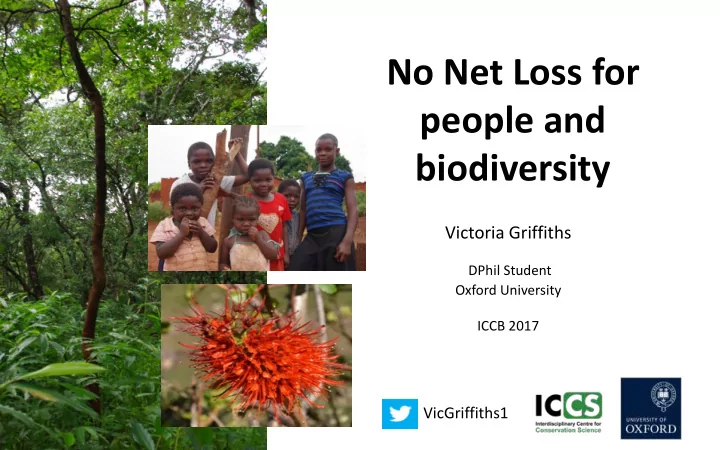

No Net Loss for people and biodiversity Victoria Griffiths DPhil Student Oxford University ICCB 2017 VicGriffiths1
Sustainable development http://ecolincnz.blogspot.co.uk/2014/07/bartering-biodiversity-offset-or-upset.html
Sustainable development Costs Benefits Society Resettlement Employment Loss of access Foreign to resources & investment CH Biodiversity Clearance Artificial reefs Pollution Rehabilitation
Mitigation hierarchy No Positive Impact, NPI + ve Offset No Net Loss, NNL Offset ACA No Net Loss Offset ual Offset PI PI PI PI Biodiversity Value act ual ual Resid Residual act act Impact R PI = Predicted Impact Av = Avoidance Min = Minimisation Min in Min R = Rehabilitation/Restoration ve Offset = Offset ACA = Additional Conservation - ve Actions (not related to footprint) Av Av Av Av BBOP 2013
Social impacts of offsetting • People’s use and cultural values associated with biodiversity? • Costs – social disparity and inequity • Benefits – improved livelihood options • Local communities should be “no worse off” (BBOP 2012, Guidance Notes) o What does this actually mean? o Who decides on what is acceptable?
Research aim • Expand NNL to include people’s social and cultural values associated with biodiversity • NNL for both people and nature? • NNL policies: achieve a NNL of biodiversity and a social NNL 1. NNL of what? 2. NNL for whom? 3. NNL compared to what? Griffiths et al. in review
1. NNL of what? • Metric for social gain and loss? Human wellbeing • Ecosystem services - essential for wellbeing • Wellbeing changes with ecosystem quality
1. NNL of what? Subjective How you feel about what you have and what you can do WELLBEING Relational Material What you can do with What you have what you have White 2009
1. NNL of what? • Perceptions influence wellbeing • Include local people in the decision- making process! • Preferences for offset activities can influence its social acceptability
2. NNL for whom? • Project-affected Persons (PAPs): – Directly / indirectly affected by changed access to natural resources – At both development and offset sites • Distribution of costs and benefits amongst PAPs (spatially and temporally) Adapted from the World Bank 2015
2. NNL for whom? Spatial gains and losses A B Before development of X the dam Y A B After development of X the dam Y Griffiths et al. in review
2. NNL for whom? • What level should social NNL be aggregated? http://www.brendansadventures.com Griffiths et al. in review https://www.e-architect.co.uk/africa
2. NNL for whom? Social NNL at regional level (aggregating villages) A B All HHs: free access Before development X to natural of the dam resources Y A B Overall NNL at After development X regional level of the dam Y Griffiths et al. in review
2. NNL for whom? Social NNL at village level (aggregating HHs in village) A B Before development X All 4 HHs have free access of the dam to natural resources All HHs lose access to natural A B resources get compensation After development X get no compensation of the dam Overall NNL for village
2. NNL for whom? Measuring NNL at these levels is difficult Measuring NNL at these levels is easier BUT Social and economic inequity arises http://www.brendansadventures.com https://www.e-architect.co.uk/africa ID PAPs and understand inequality in the system • Griffiths et al. in review
2. NNL for whom? Temporal gains and losses A B X • People also tend to place more value on what they have now Ø Feel immediate loss of biodiversity much more than future gains Compensate PAPs throughout the project lifecycle •
3. NNL compared to what? • Frame of reference (baseline or counterfactual) needed Perceived baselines Objective baselines https://www.123rf.com/ https://heathermanes.wordpress.com • Selected baseline – acceptable to external parties but reflect PAPs lived experience Griffiths et al. in review
Conclusion: defining social NNL Project-affected people NNL for whom? (appropriately aggregated) NNL of what? should perceive their wellbeing to be at least as good as a result of the development project and associated biodiversity offset, throughout the project lifecycle, than if the development had NNL compared to what? not been implemented Griffiths et al. in review
Thank you and questions? Acknowledgements: • E.J. Milner-Gulland • Joseph Bull • Julia Baker Email: victoria.griffiths@bnc.ox.ac.uk VicGriffiths1
Recommend
More recommend